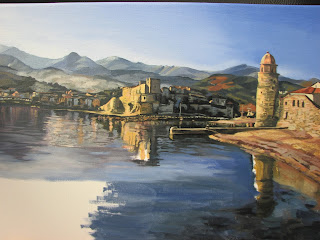This painting was done all the way back in May but had to stay hush hush as it was a present for my sister's first wedding anniversary commissioned by her husband. Somehow, despite not telling my mum about the painting I was doing, she still managed to let slip to my sister a couple of days before.. oops!
It's something very different from my usual wildlife and pet pictures, a landscape of Collioure - a seaside town in the south of France where they spent their honeymoon. The first anniversary is paper which gave my brother-in-law the idea for a painting gift. It was done in a looser style than I usually work, focussing on the light and colour to give more of an impressionist piece.
Here are the stages of the painting:






























